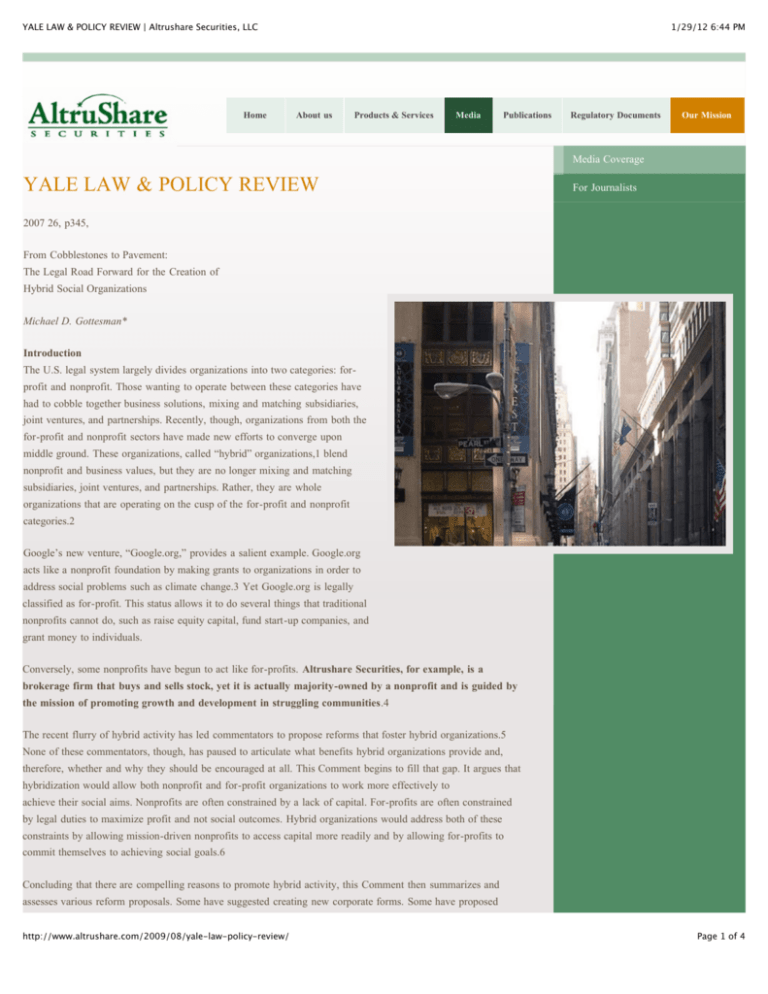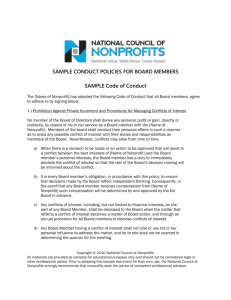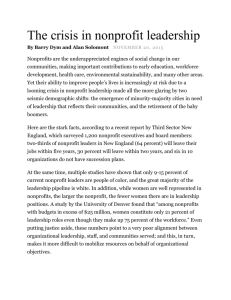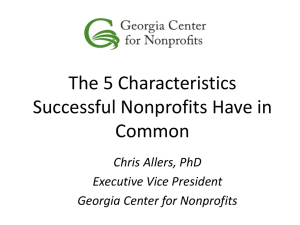
YALE LAW & POLICY REVIEW | Altrushare Securities, LLC
1/29/12 6:44 PM
AlturShare
Home
About us
Products & Services
Media
Publications
Regulatory Documents
Our Mission
Media Coverage
YALE LAW & POLICY REVIEW
For Journalists
2007 26, p345,
From Cobblestones to Pavement:
The Legal Road Forward for the Creation of
Hybrid Social Organizations
Michael D. Gottesman*
Introduction
The U.S. legal system largely divides organizations into two categories: forprofit and nonprofit. Those wanting to operate between these categories have
had to cobble together business solutions, mixing and matching subsidiaries,
joint ventures, and partnerships. Recently, though, organizations from both the
for-profit and nonprofit sectors have made new efforts to converge upon
middle ground. These organizations, called “hybrid” organizations,1 blend
nonprofit and business values, but they are no longer mixing and matching
subsidiaries, joint ventures, and partnerships. Rather, they are whole
organizations that are operating on the cusp of the for-profit and nonprofit
categories.2
Google’s new venture, “Google.org,” provides a salient example. Google.org
acts like a nonprofit foundation by making grants to organizations in order to
address social problems such as climate change.3 Yet Google.org is legally
classified as for-profit. This status allows it to do several things that traditional
nonprofits cannot do, such as raise equity capital, fund start-up companies, and
grant money to individuals.
Conversely, some nonprofits have begun to act like for-profits. Altrushare Securities, for example, is a
brokerage firm that buys and sells stock, yet it is actually majority-owned by a nonprofit and is guided by
the mission of promoting growth and development in struggling communities.4
The recent flurry of hybrid activity has led commentators to propose reforms that foster hybrid organizations.5
None of these commentators, though, has paused to articulate what benefits hybrid organizations provide and,
therefore, whether and why they should be encouraged at all. This Comment begins to fill that gap. It argues that
hybridization would allow both nonprofit and for-profit organizations to work more effectively to
achieve their social aims. Nonprofits are often constrained by a lack of capital. For-profits are often constrained
by legal duties to maximize profit and not social outcomes. Hybrid organizations would address both of these
constraints by allowing mission-driven nonprofits to access capital more readily and by allowing for-profits to
commit themselves to achieving social goals.6
Concluding that there are compelling reasons to promote hybrid activity, this Comment then summarizes and
assesses various reform proposals. Some have suggested creating new corporate forms. Some have proposed
http://www.altrushare.com/2009/08/yale-law-policy-review/
Page 1 of 4
YALE LAW & POLICY REVIEW | Altrushare Securities, LLC
1/29/12 6:44 PM
revamping tax laws. Some have argued for working within the existing corporate law to explore hybrids’
potential. This Comment assesses the proposals offered to date and charts a way forward. Ultimately, this
Comment argues that organizations can and should continue to explore hybrid activity while working within the
existing laws.
I. Affirmative Arguments for Hybrid Activity
The discussion about legal reform to foster hybrid activity has not focused on the question of why more hybrid
activity would be good. By briefly outlining affirmative arguments for hybrid activity from both the for-profit
and the nonprofit perspectives, this Part tries to bring greater clarity to—or at least to provoke further discussion
of—this preliminary issue of why we want hybrid organizations. Each section describes problems that result from
the binary classification of organizations and outlines the argument for how a new hybrid structure can help
overcome these problems.
A. From the Nonprofits’ Perspective
There are two broad categories of nonprofit organizations: service organizations, which spend money in support
of social goals, and grantmaking foundations, which raise money and distribute it to service organizations. The
law treats these two types of nonprofits differently, and each type faces different obstacles when attempting to
engage in hybrid activity. Whereas service organizations worry most about regulations governing how they can
get money, foundations worry most about regulations governing how they can spend money.
The overarching problem service organizations confront in the current binary system—in which social
organizations are forced into one of two legal categories, for-profit and nonprofit—is one of access to capital.
This problem manifests itself in a number of ways. First, these nonprofits must generate their own revenue in the
face of manifold legal restrictions on profit-making activity. Historical developments have created pressure for
nonprofits to generate their own revenue. Starting with President Reagan, the government has shifted more
responsibility to nonprofits for providing social services, while at the same time reducing nonprofit funding.7 To
keep their doors open, nonprofits learned to find money elsewhere, including generating it themselves. Then,
during the rise of internet entrepreneurship in the 1990s, general enthusiasm for innovative business methods
reached a fever pitch. In this environment nonprofit managers wanted to be seen as entrepreneurial, too,8 and
nonprofit funders also began demanding that
nonprofits be innovative in how they generate money.9
Yet, laws limit the extent to which nonprofits may use entrepreneurial business methods. To win exempt status, a
nonprofit “must be both organized and operated exclusively for one or more exempt purposes.”10 Pursuing
public benefit is an “exempt purpose”; pursuing profit usually is not.11 Then, once an organization has secured
exempt status, it still faces taxes on certain profits—those that result from trade or business regularly carried out
and not substantially related to the performance of an organization’s
exempt purposes.12 Thus, at the same time that nonprofits face pressure to generate revenue, the legal system
also creates disincentives to generate revenue. A more capacious legal structure that allows organizations to
pursue public benefit and does not impose such stringent restrictions on generating revenue would help resolve
this tension.
The second conundrum service organizations face in accessing capital is that they cannot raise equity capital (i.e.,
capital raised by owners). A for-profit can raise capital by attracting investors; if it succeeds, it pays some
financial return to those investors. Nonprofits cannot do this because they cannot distribute profits.13 As a result,
the nonprofit capital market is less disciplined than the for-profit capital market. Money does not always follow
success in the nonprofit market14—money often flows to new ideas rather than proven ones.15
* Yale Law School, J.D. expected 2008; University of Cambridge, M.Phil. 2003; Yale College, B.A. 2002. The
author wishes to thank Annie Decker, Gail Fine, and Alex Neuhoff for their comments on this piece, Professor
John Simon for his guidance, and Julianna Bentes for her patient, careful editing. The author welcomes comments
http://www.altrushare.com/2009/08/yale-law-policy-review/
Page 2 of 4
YALE LAW & POLICY REVIEW | Altrushare Securities, LLC
1/29/12 6:44 PM
at michael.d.gottesman@gmail.com.
1. See, e.g., Press Release, Nonprofit Sector Research Fund, Nonprofit Sector Research Fund Supports Study of
“Hybrid” Organizations Seeking Social Change and Economic Change (Apr. 22, 2004), available at
ww.nonprofitresearch.org/newsletter1525/newsletter_show.htm? doc_id=224494.
2. In the past year alone, the New York Times has noted this trend toward hybridization three times. See David
Haskell, The Sixth Annual Year in Ideas; For-Profit Philanthropy, N.Y. Times, Dec. 10, 2006, § 6 (Magazine) at
50; Stephanie Strom, Make Money, Save the World, N.Y. Times, May 6, 2007, at C1; Stephanie Strom, What’s
Wrong with Profit?, N.Y. Times, Nov. 13, 2006, at F1.
3. Katie Hafner, Philanthropy Google’s Way: Not the Usual, N.Y. Times, Sept. 14, 2006, at A1.
4. Altrushare Securities, History and Mission, http://www.altrushare.com/apps/
altrushare/as_history_and_mission.html (last visited Dec. 13, 2007).
5. See, e.g., Thomas J. Billitteri, The Aspen Institute, Nonprofit Sector Research Fund, Mixing Mission and
Business: Does Social Enterprise Need a New Legal Approach (2007), www.nonprofitresearch.org/usr_doc/
New_Legal_Forms_Report_FINAL.pdf.
6. If these organizations face fewer structural constraints on pursuit of social goals, the ultimate beneficiaries of
these organizations—e.g., the environment, individuals in need of social services, etc.—will benefit. This
Comment does not discuss in detail how hybrid organizations will better serve those beneficiaries. It focuses
instead on how to overcome the structural constraints on organizations.
7. Lester M. Salamon & Alan J. Abramson, The Federal Budget and the Nonprofit Sector 3 (1982). William
Foster and Gail Fine suggest that the data tell a different story, but they do not entirely negate this point because
they do not specify whether government funding has kept pace with the increased demands government has been
placing on nonprofits. William Foster & Gail Fine, How Nonprofits Get Really Big, Stan. Soc. Innovation Rev.,
Spring 2007, at 46, 53. (“Many people talk about the government getting out of the social sector, but available
data tell a different story. Not only our findings, but also national data show that government funding of the
nonprofit
sector is growing faster than the nation’s GDP.”).
8. William Foster & Jeffrey Bradach, Should Nonprofits Seek Profits?, Harv. Bus. Rev., Feb. 2005, at 92, 92.
9. Id. at 95.
10. 26 C.F.R. § 1.501(c)(3)-(1)(a)(1) (2007).
11. Although the doctrines growing out of this restriction are complex, in practice, this provision threatens to
revoke favorable tax status for nonprofits that engage in too much profit-making activity. For helpful discussions
of this topic, see John D. Colombo, Commercial Activity and Charitable Tax Exemption, 44 Wm. & Mary L.
Rev. 487, 495-507 (2002); and Thomas Kelley, Rediscovering Vulgar Charity: A Historical Analysis of
America’s Tangled Nonprofit Law, 73 Fordham L. Rev. 2437, 2473-83 (2005).
12. This tax is called the Unrelated Business Income Tax (UBIT). 26 U.S.C. § 513
(2000); 26 C.F.R. § 1.513-1 (2007).
13. Henry B. Hansmann, Reforming Nonprofit Corporation Law, 129 U. Pa. L. Rev. 497, 501 (1981) (discussing
how nonprofits are “barred from distributing profits, or net earnings, to individuals who exercise control over it,
such as directors, officers, or members”).
http://www.altrushare.com/2009/08/yale-law-policy-review/
Page 3 of 4
YALE LAW & POLICY REVIEW | Altrushare Securities, LLC
1/29/12 6:44 PM
14. “The fact that dollars seldom follow success is one of the most vexing challenges nonprofit leaders face . . . .
[T]he consequence is that proven solutions to pressing problems do not spread.” Jeffrey L. Bradach, Going to
Scale
© Copyright 2009 AltruShare Securities | All rights reserved.
http://www.altrushare.com/2009/08/yale-law-policy-review/
Page 4 of 4









